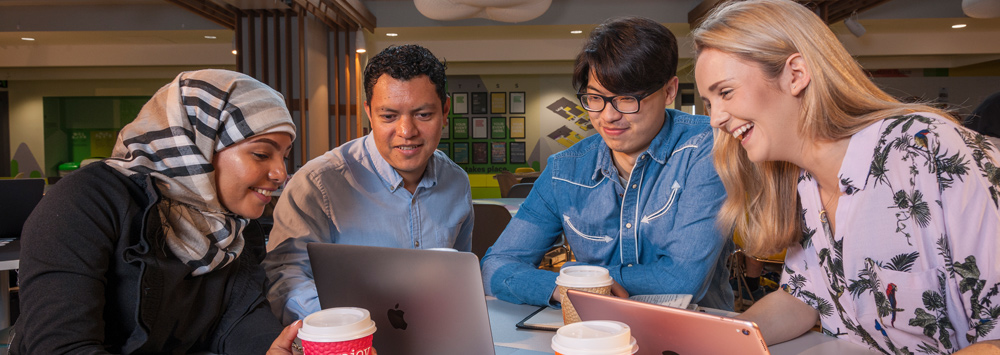Benefits
- Students hold the ‘learner perspective’, bringing fresh ideas and approaches.
- Students are given agency to make changes to their learning experience, which can be a strong source of motivation and engagement, with sense of belonging and ownership.
- Students develop transferable skills, confidence and sense of citizenship. Gaining new perspectives on problems and experience of negotiation is useful in employment.
- Staff can gain from richer feedback that is more representative compared to other data collection methods, and can be acted upon with greater visibility.
Examples of student-staff partnership
Here are a few examples from this varied and developing area:
- Project-based where students explore a specific area within their teaching & learning. Goals, process and outcome are defined collaboratively by students and staff (Mercer-Mapstone & Marie, 2019). Project groups feedback the results to the tutor or client (e.g. the University) and may contribute towards assessment, through a reflective task for example.
- Course evaluation workshops scheduled within the course timetable that focus on the cohort’s learning experience, with activities designed to frame discussion and prioritise development.
- Curriculum enhancement projects where funds are available, often at the university level, to employ students to undertake specific pieces of work within teaching & learning design.
- Co-creation of curriculum design, for example student participation in learning design workshops organised to tie in with new programme approval or review processes.
- University-wide Student Panels, representative of the wider student population brought in to solve specific problems or help design new curriculum frameworks.
Putting it into practice
Varied form and context of student-staff partnerships means that a ‘one size fits all’ approach is inappropriate. Instead here is broad advice for founding your SSP:
- Before you start, ask yourself what it is that you want to achieve. Mercer-Mapstone et al. (2019) recommend starting out with three basic questions which help buy-in and chances of success: Why is partnership important to you/the course? How will partnership be initiated and fostered? What will it look like?
- Take a look at what is already happening. Are student engagement activities in place that you can capitalise upon with your design (e.g. strong course rep presence or societies)? Are there advocates for student-staff partnerships locally or within networks that you can gain support from? Is any funding support available?
- Think about the additional support that your students might need in this new way of working, from the outset but also as the project proceeds. Can you put in place milestones to help them along, or bring in outside help?
- Find ways to encourage engaged participation. For amazing things to happen, can you increase opportunities for engagement and dialogue with students? You might like to consider using classroom response technologies in lectures such as PollEverywhere or Padlet, shown to initiate and increase two-way communication (Middleditch et al., 2015), or you could work through questions and answers to surveys such as the Irish Survey of Student Engagement to initiate discussion.
- Try things out on a small-scale, and build up year-on-year. Be happy to experiment, take your students with you as innovation partners, expect that not everything will work but recognise the learning opportunities.
- Make time to reflect and ‘shout-out’ about your student-staff partnership. Give participants the recognition they deserve, organise a ‘mini-conference’ or celebration event where students and staff can feed back their findings to the school or university. If the partnership leads to change let your student partners know, and highlight to incoming students to keep the wheel of student engagement and partnership turning.
- Plan for next year. Work with students to help evaluate what worked and what did not. Can you plant any new seeds such as inviting back past students to talk to the new intake or helping any others do the same?
Interpreting Levels of Student-Staff Partnership
A useful model for explaining and assessing student-staff partnership projects has been put forward by Fletcher (2011), where degrees of student engagement are rungs on a ladder.
At lower levels emphasis is placed on student attendance rather than participation, whereas higher levels focus on consultation, leading to projects that are directed and run by students (facilitated by staff), with outputs that are recognised and respected.
References
Fletcher, A. (2014). The guide to student voice. ISBN9780692217320. Extract can be found here: Ladder of Student Involvement in Schools.
Higher Education Academy. Framework for student engagement through partnership.
Mercer-Mapstone, L., & Marie, J. (2019). PRACTICAL GUIDE Scaling up student-staff partnership in higher education.
Middleditch, P., & Moindrot, W. (2015). Using classroom response systems for creative interaction and engagement with students. Cogent Economics and Finance, 3(1).
Help and Feedback
Can you help us improve this resource or suggest a future one? Do you need this resource in an alternative format? Please contact us at cie@liverpool.ac.uk

Student-Staff Partnership by William Moindrot is licensed under a Creative Commons Attribution-NonCommercial 4.0 International License.

